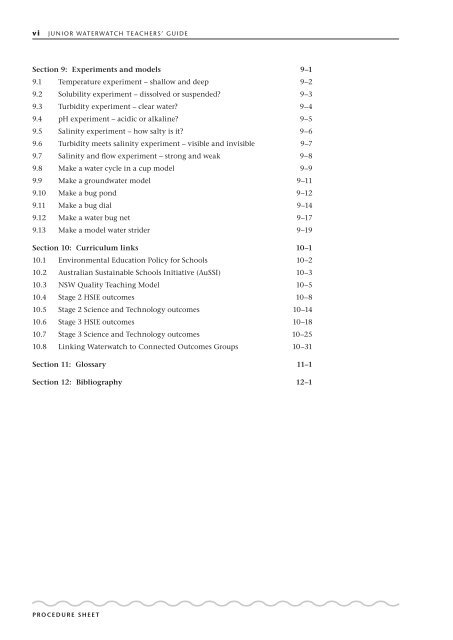Junior Waterwatch Teachers' Guide - Department of Environment ...
Junior Waterwatch Teachers' Guide - Department of Environment ...
Junior Waterwatch Teachers' Guide - Department of Environment ...
Create successful ePaper yourself
Turn your PDF publications into a flip-book with our unique Google optimized e-Paper software.
vi JUNIOR WATERWATCH TEACHERS’ GUIDE<br />
Section 9: Experiments and models 9–1<br />
9.1 Temperature experiment – shallow and deep 9–2<br />
9.2 Solubility experiment – dissolved or suspended? 9–3<br />
9.3 Turbidity experiment – clear water? 9–4<br />
9.4 pH experiment – acidic or alkaline? 9–5<br />
9.5 Salinity experiment – how salty is it? 9–6<br />
9.6 Turbidity meets salinity experiment – visible and invisible 9–7<br />
9.7 Salinity and flow experiment – strong and weak 9–8<br />
9.8 Make a water cycle in a cup model 9–9<br />
9.9 Make a groundwater model 9–11<br />
9.10 Make a bug pond 9–12<br />
9.11 Make a bug dial 9–14<br />
9.12 Make a water bug net 9–17<br />
9.13 Make a model water strider 9–19<br />
Section 10: Curriculum links 10–1<br />
10.1 <strong>Environment</strong>al Education Policy for Schools 10–2<br />
10.2 Australian Sustainable Schools Initiative (AuSSI) 10–3<br />
10.3 NSW Quality Teaching Model 10–5<br />
10.4 Stage 2 HSIE outcomes 10–8<br />
10.5 Stage 2 Science and Technology outcomes 10–14<br />
10.6 Stage 3 HSIE outcomes 10–18<br />
10.7 Stage 3 Science and Technology outcomes 10–25<br />
10.8 Linking <strong>Waterwatch</strong> to Connected Outcomes Groups 10–31<br />
Section 11: Glossary 11–1<br />
Section 12: Bibliography 12–1<br />
PROCEDURE SHEET
















